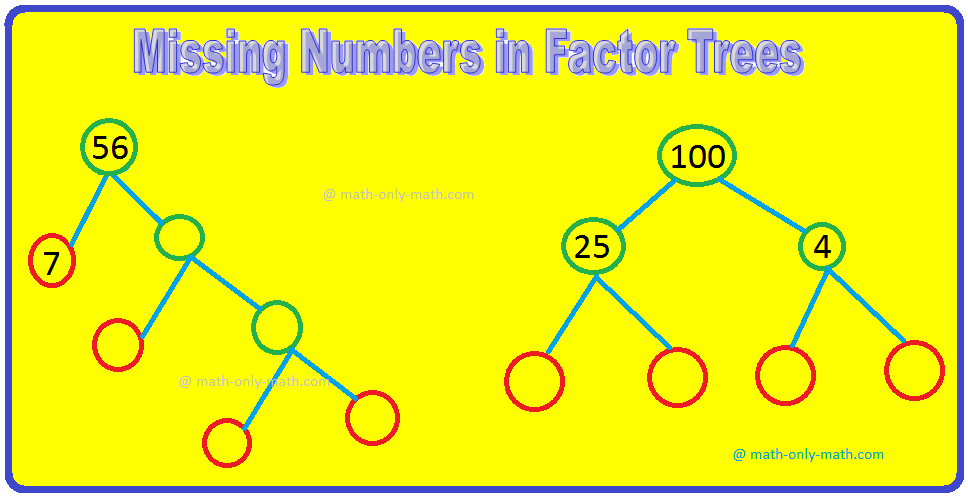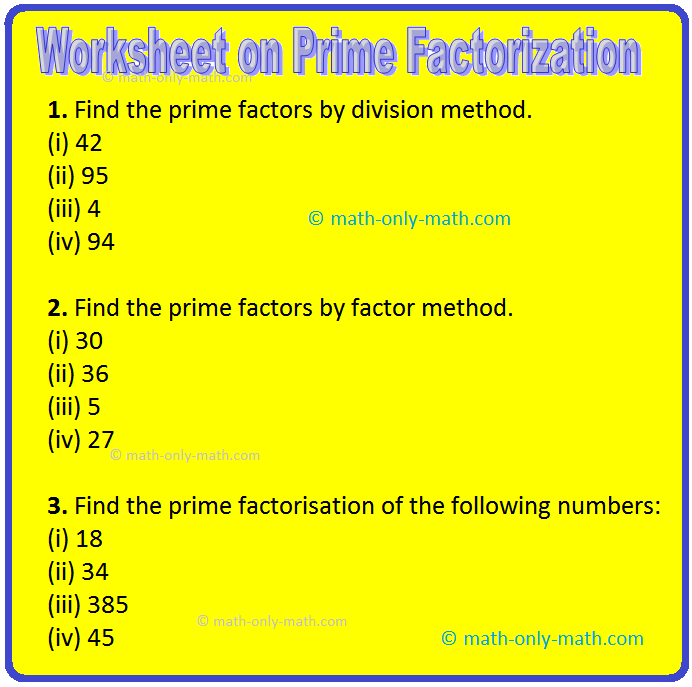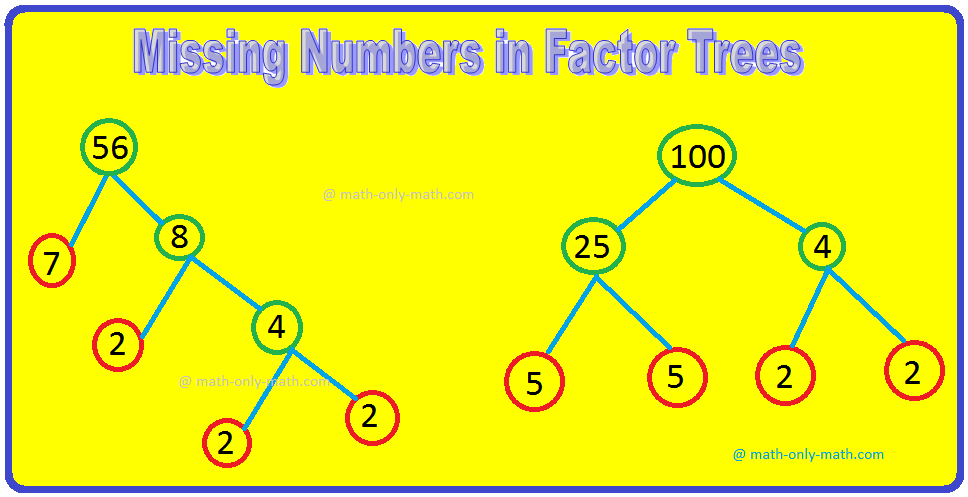Subscribe to our ▶️ YouTube channel 🔴 for the latest videos, updates, and tips.
Worksheet on Methods of Prime Factorization
Practice the questions given in the worksheet on methods of prime factorization.
1. Each of the following is the prime factorization of a certain number. Find the number.
(i) 2 × 5 × 7
(ii) 3 × 7 × 7
(iii) 2 × 7 × 13
(iv) 2 × 2 × 3 × 5
(v) 7 × 11 × 11
(vi) 5 × 5 × 7
(vii) 3 × 3 × 7
(viii) 2 × 3 × 3 × 7
(ix) 3 × 5 × 5 × 7
2. Find the prime factors by division method.
(i) 42
(ii) 95
(iii) 4
(iv) 94
(v) 28
(vi) 52
(vii) 40
(viii) 84
3. Find the prime factors by factor method.
(i) 30
(ii) 36
(iii) 5
(iv) 27
(v) 72
(vi) 56
(vii) 80
(viii) 96
4. Write the missing numbers in the factor trees.
5. Determine the prime factorization by any method you like.
(i) 2
(ii) 86
(iii) 50
(iv) 68
(v) 74
(vi) 90
(vii) 88
(viii) 48
(ix) 81
(x) 42
(xi) 66
(xii) 45
6. Multiple Choice Questions (MCQ) on Prime Factorization:
Tick (✔) the correct option.
(i) Prime factorisation of 54 is:
(a) 2 × 27
(b) 2 × 3 × 9
(c) 54 × 1
(d) 2 × 3 × 3 × 3
(ii) 2 × 3 × 7 is the prime factorisation of
(a) 21
(b) 1237
(c) 237
(d) 42
7. Find the prime factorisation of the following numbers:
(i) 18
(ii) 34
(iii) 385
(iv) 45
(v) 52
(vi) 64
(vii) 390
(viii) 2520
(ix) 1210
(x) 1260
(xi) 1024
(xii) 2520
Answers for the worksheet on methods of prime factorization are given below.
Answers:
1. (i) 10
(ii) 147
(iii) 182
(iv) 60
(v) 847
(vi) 175
(vii) 63
(viii) 126
(ix) 525
2. (i) 2 × 3 × 7
(ii) 5 × 19
(iii) 2 × 2
(iv) 2× 47
(v) 2 × 2 × 7
(vi) 2 × 2 × 13
(vii) 2 × 2 × 2 × 5
(viii) 2 × 2 × 3 × 7
3. (i) 2 × 3 × 5
(ii) 2 × 2 × 3 × 3
(iii) 1 × 5
(iv) 3 × 3 × 3
(v) 2 × 2 × 2 × 3 × 3
(vi) 2 × 2 × 2 × 7
(vii) 2 × 2 × 2 × 2 × 5
(viii) 2 × 2 × 2 × 2 × 2 × 3
4.
5. (i) 1 × 2
(ii) 2 × 43
(iii) 2 × 5 × 5
(iv) 2 × 2 × 17
(v) 2 × 37
(vi) 2 × 5 × 9
(vii) 2 × 2 × 2 × 11
(viii) 2 × 2 × 2 × 2 × 3
(ix) 3 × 3 × 3 × 3
(x) 2 × 3 × 7
(xi) 2 × 3 × 11
(xii) 3 × 3 × 5
6. (d) 2 × 3 × 3 × 3
(ii) (d) 42
7. (i) 18 = 1 × 2 × 3 × 3
(ii) 34 = 1 × 3 × 13
(iii) 385 = 1 × 5 × 7 × 11
(iv) 45 = 1 × 3 × 3 × 5
(v) 52 = 1 × 2 × 2 × 13
(vi) 64 = 1 × 2 × 2 × 2 × 2 × 2 × 2 × 2
(vii) 390 = 2 × 3 × 5 × 13
(viii) 2520 = 1 × 2 × 2 × 2 × 3 × 3 × 5 × 7
(ix) 1210 = 2 × 5 × 11 × 11
(x) 1260 = 1 × 2 × 2 × 3 × 3 × 5 × 7
(xi) 1024 = 1 × 2 × 2 × 2 × 2 × 2 × 2 × 2 × 2 × 2 × 2
(xii) 2520 = 1 × 2 × 2 × 2 × 3 × 3 × 5 × 7
From Worksheet on Methods of Prime Factorization to HOME PAGE
Didn't find what you were looking for? Or want to know more information about Math Only Math. Use this Google Search to find what you need.





New! Comments
Have your say about what you just read! Leave me a comment in the box below. Ask a Question or Answer a Question.